动词加ed和ing规则
- 格式:doc
- 大小:267.00 KB
- 文档页数:39
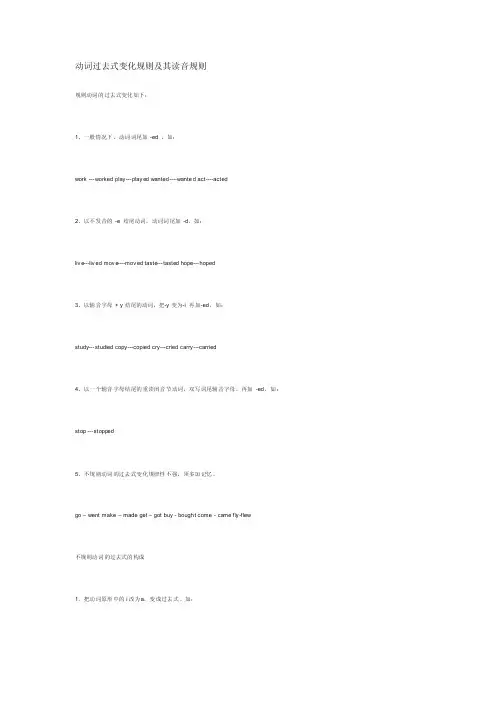
动词过去式变化规则及其读音规则规则动词的过去式变化如下:1、一般情况下,动词词尾加-ed ,如:work ---worked play---play ed wanted----wanted act----acted2、以不发音的-e 结尾动词,动词词尾加-d,如:liv e---liv edmov e----mov edtaste---tasted hope---hoped3、以辅音字母+ y结尾的动词,把-y变为-i 再加-ed,如:study---studie d copy---copied cry---criedcarry---carrie d4、以一个辅音字母结尾的重读闭音节动词,双写词尾辅音字母,再加-ed,如:stop ---stoppe d5、不规则动词的过去式变化规律性不强,须多加记忆。
go – went make – made get – got buy- bought come - came f ly-flew不规则动词的过去式的构成1.把动词原形中的i改为a,变成过去式。
如:begin—began,drink—drank,giv e—gav e,ring—rang,sing—sang,sit—sat,swim—swam 2.把重读开音节中的i改为o,变成过去式。
如:driv e—drov e,ride—rode,write—wrote3.改动词原形中的aw /ow为ew,变成过去式。
如:draw—drew,grow—grew,know—knew,throw—threw(动词show除外,show—showed)4.动词原形中的e改为o,变成过去式。
如:get—got,f orget—f orgot5.动词原形中的ee改为e,变成过去式。
如:f eed—f ed,meet—met6.动词原形中的eep改为ept,变成过去式。
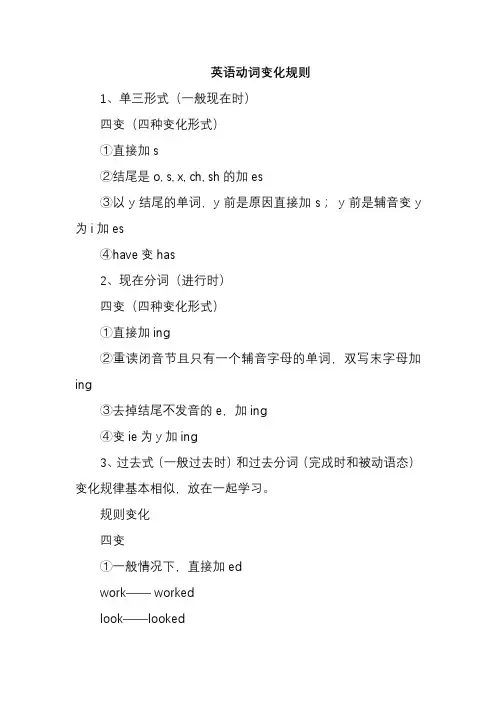
英语动词变化规则
1、单三形式(一般现在时)
四变(四种变化形式)
①直接加s
②结尾是o, s, x, ch, sh的加es
③以y结尾的单词,y前是原因直接加s;y前是辅音变y 为i加es
④have变has
2、现在分词(进行时)
四变(四种变化形式)
①直接加ing
②重读闭音节且只有一个辅音字母的单词,双写末字母加ing
③去掉结尾不发音的e,加ing
④变ie为y加ing
3、过去式(一般过去时)和过去分词(完成时和被动语态)变化规律基本相似,放在一起学习。
规则变化
四变
①一般情况下,直接加ed
work—— worked
look——looked
walk——walked
②以e结尾的单词,直接加d
live ——lived
hope——hoped
use——used
③以y结尾的单词
以辅音字母+y结尾的,变y为i加ed
study——studied
carry——carried
以元音字母+y结尾的,直接加ed
enjoy ——enjoyed
play——played
④以重读、一个辅音字母结尾的闭音节结尾的动词,双写最后的辅音字母+ed
stop—— stopped
plan——planned
prefer——preferred。
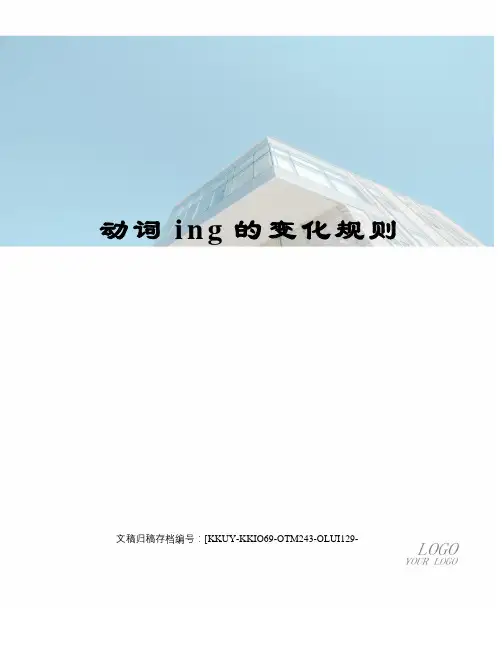
动词i n g的变化规则文稿归稿存档编号:[KKUY-KKIO69-OTM243-OLUI129-动词的第三人称单数的变化规则1、一般情况下,动词后面直接加-s.work-worksget-getssay-saysread-reads2、以辅音字母+y结尾的动词,把y变为i再加-es.例如:study-studiestry-triescarry-carriesfly-fliescry-cries3、以ch,sh,s,x,o结尾的动词,在后面加-es。
go-goesteach-teacheswash-washesbrush-brushescatch-catchesdo-doesfix-fixes动词ing的变化规则1.一般动词直接加–inggo---goingwork---workinglook---looking2.以-y结尾的动词,直接加-ingsay---sayingenjoy---enjoyingcry---cryingcarry---carryingstudy---studying3.以ie结尾的动词,变ie为y再加–ingdie---dying,lie---lying,tie---tying4.以不发音的e结尾的动词,去e加–ingmake-makingwrite-writinglove-writinghate-hatinghope-hopingtake-takingsave-savingbreathe-breathingproduce-producing注意:be-beingsee-seeingagree-agreeing5.以重读闭音节结尾,末尾只有一个辅音字母的动词,要双写这一辅音字母,再加-ing。
begin-beginningadmit-admittingsit-sittingfit-fittinghit-hittingprefer-preferringswim-swimmingshop-shoppingcut-cuttingget-gettingforget-forgettingspit-spittingshut-shuttingstop-stoppingplan-planningdig-diggingdrop-droppingstep-stepping注意:blow-blowinggrow-growingdraw-drawingbow-bowingshow-showingknow-knowing动词过去式和过去分词的变化规则规则变化:1.一般在动词词尾直接加ed。
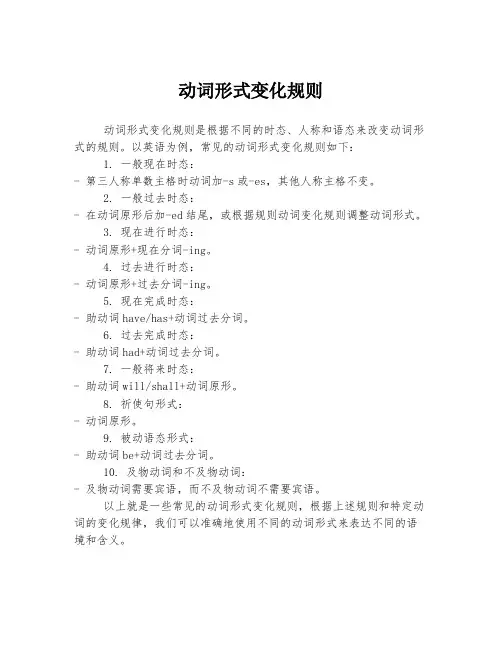
动词形式变化规则
动词形式变化规则是根据不同的时态、人称和语态来改变动词形式的规则。
以英语为例,常见的动词形式变化规则如下:
1. 一般现在时态:
- 第三人称单数主格时动词加-s或-es,其他人称主格不变。
2. 一般过去时态:
- 在动词原形后加-ed结尾,或根据规则动词变化规则调整动词形式。
3. 现在进行时态:
- 动词原形+现在分词-ing。
4. 过去进行时态:
- 动词原形+过去分词-ing。
5. 现在完成时态:
- 助动词have/has+动词过去分词。
6. 过去完成时态:
- 助动词had+动词过去分词。
7. 一般将来时态:
- 助动词will/shall+动词原形。
8. 祈使句形式:
- 动词原形。
9. 被动语态形式:
- 助动词be+动词过去分词。
10. 及物动词和不及物动词:
- 及物动词需要宾语,而不及物动词不需要宾语。
以上就是一些常见的动词形式变化规则,根据上述规则和特定动词的变化规律,我们可以准确地使用不同的动词形式来表达不同的语境和含义。
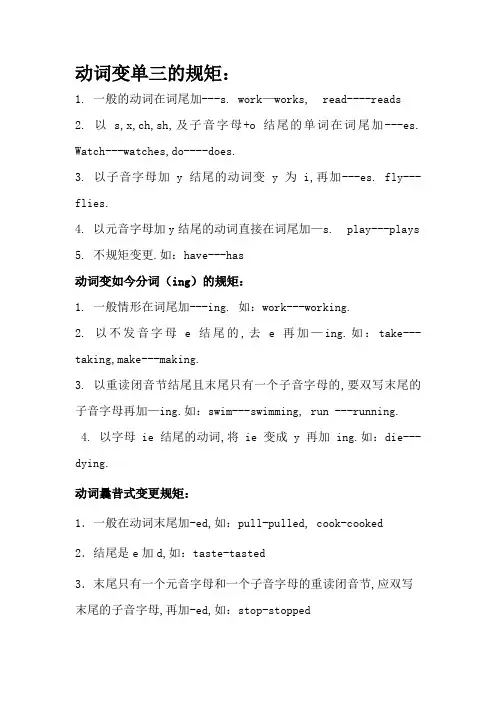
动词变单三的规矩:1. 一般的动词在词尾加---s. work—works, read----reads2. 以s,x,ch,sh,及子音字母+o结尾的单词在词尾加---es. Watch---watches,do----does.3. 以子音字母加y结尾的动词变y为i,再加---es. fly---flies.4. 以元音字母加y结尾的动词直接在词尾加—s. play---plays5. 不规矩变更.如:have---has动词变如今分词(ing)的规矩:1. 一般情形在词尾加---ing. 如:work---working.2. 以不发音字母e结尾的,去e再加—ing.如:take---taking,make---making.3. 以重读闭音节结尾且末尾只有一个子音字母的,要双写末尾的子音字母再加—ing.如:swim---swimming, run ---running.4. 以字母ie结尾的动词,将ie变成y再加 ing.如:die---dying.动词曩昔式变更规矩:1.一般在动词末尾加-ed,如:pull-pulled, cook-cooked2.结尾是e加d,如:taste-tasted3.末尾只有一个元音字母和一个子音字母的重读闭音节,应双写末尾的子音字母,再加-ed,如:stop-stopped4.以“子音字母+y”结尾的,变y为i, 再加-ed,如:study-studiedAB型can could shall should will would may mightAAA型cost cost cost cut cut cut hit hit hit hurt hurt hurt let let letmust must must put put put set set set shut shut shut read read readAAB型beat beat beatenABA型become became become come came come run ran runABB型bring brought brought buy bought bought think thought thoughtcatch caught caught teach taught taught build built builtlend lent lent send sent sent spend spent spentdig dug dug hang hung hung feel felt feltkeep kept kept sleep slept slept sweep swept sweptleave left left smell smelt smelt spill spilt spiltlay laid laid pay paid paid say said saidsell sold sold tell told told sit sat satspit spat spat stand stood stood understand understood understoodlearn learnt learnt mean meant meant spoil spoilt spoiltshine shone shone win won won have had hadmake made made hear heard heard find found found hold held held ABC型begin began begun drink drank drunk ring rang rungsing sang sung sink sank sunk swim swam swum blow blew blown fly flew flowngrow grew grown know knew known throw threw thrown draw drew drawn show showed shown break broke broken choose chose chosen forget forgot forgotten freeze froze frozen speak spoke spoken wake woke wokendrive drove driveneat ate eatenfall fell fallengive gave givenhide hid hiddenride rode riddenrise rose risentake took takenmistake mistook mistaken write wrote writtenam/is was beenare were beendo did donego went gonelie lay lainsee saw seenwear wore worn易错型show showed showndraw drew drawnfall fell fallenfeel felt felthold held heldhelp helped helpedthink thought thoughtthank thanked thankedtake took takentalk talked talkedget got gotforget forgot forgottenmeet met metmean meant meanthit hit hithide hid hiddenring rang rungbring brought broughteat ate eatenbeat beat beatenlie lay lainlay laid laidfind found foundfound founded foundedbuy bought boughtbring brought broughtlearn learnt learnthear heard heard5.曩昔式和曩昔分词有两种情势(以下满是ABB)burn burned burnedburnt burntlearn learned learnedlearnt learnt smell smelled smelledsmelt smelt spell spelled spelledspelt spelt shine shined shinedshone shone leap leaped leapedleapt leapt。
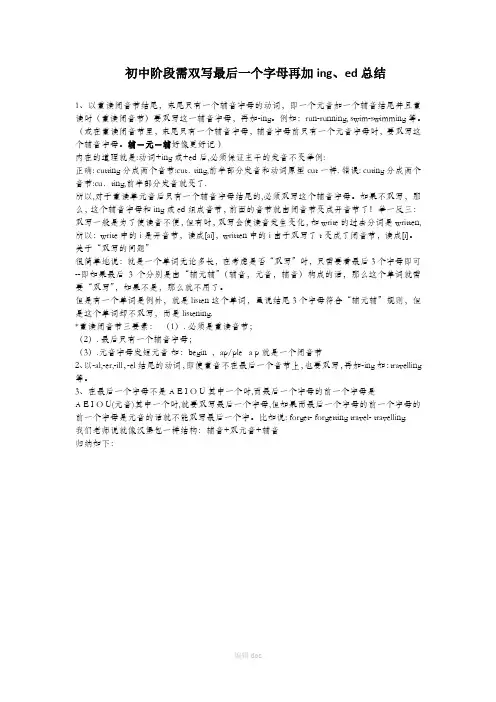
初中阶段需双写最后一个字母再加ing、ed总结1、以重读闭音节结尾,末尾只有一个辅音字母的动词,即一个元音加一个辅音结尾并且重读时(重读闭音节)要双写这一辅音字母,再加-ing。
例如:run-running, swim-swimming等。
(或在重读闭音节里,末尾只有一个辅音字母,辅音字母前只有一个元音字母时,要双写这个辅音字母。
辅-元-辅好像更好记)内在的道理就是:动词+ing或+ed后,必须保证主干的发音不变举例:正确: cutting分成两个音节:cut.ting,前半部分发音和动词原型cut一样. 错误: cuting分成两个音节:cu.ting,前半部分发音就变了.所以,对于重读单元音后只有一个辅音字母结尾的,必须双写这个辅音字母。
如果不双写,那么,这个辅音字母和ing或ed组成音节,前面的音节就由闭音节变成开音节了!举一反三:双写一般是为了使读音不便,但有时,双写会使读音发生变化,如write的过去分词是written,所以:write中的i是开音节,读成[ai],written中的i由于双写了t变成了闭音节,读成[i]。
关于“双写的问题”很简单地说:就是一个单词无论多长,在考虑是否“双写”时,只需要看最后3个字母即可--即如果最后3个分别是由“辅元辅”(辅音,元音,辅音)构成的话,那么这个单词就需要“双写”,如果不是,那么就不用了。
但是有一个单词是例外,就是listen这个单词,虽说结尾3个字母符合“辅元辅”规则,但是这个单词却不双写,而是listening.*重读闭音节三要素:(1). 必须是重读音节;(2). 最后只有一个辅音字母;(3).元音字母发短元音如:begin ,ap/ple a p 就是一个闭音节2、以-al,-er,-ill,-el结尾的动词,即使重音不在最后一个音节上,也要双写,再加-ing 如:travelling 等。
3、在最后一个字母不是A E I O U其中一个时,而最后一个字母的前一个字母是A E I O U(元音)其中一个时,就要双写最后一个字母,但如果而最后一个字母的前一个字母的前一个字母是元音的话就不能双写最后一个字。
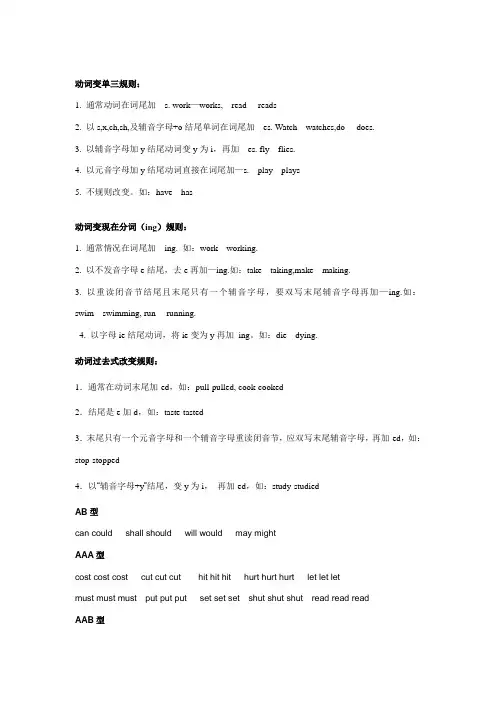
动词变单三规则:1. 通常动词在词尾加---s. work—works, read----reads2. 以s,x,ch,sh,及辅音字母+o结尾单词在词尾加---es. Watch---watches,do----does.3. 以辅音字母加y结尾动词变y为i,再加---es. fly---flies.4. 以元音字母加y结尾动词直接在词尾加—s. play---plays5. 不规则改变。
如:have---has动词变现在分词(ing)规则:1. 通常情况在词尾加---ing. 如:work---working.2. 以不发音字母e结尾,去e再加—ing.如:take---taking,make---making.3. 以重读闭音节结尾且末尾只有一个辅音字母,要双写末尾辅音字母再加—ing.如:swim---swimming, run ---running.4. 以字母ie结尾动词,将ie变为y再加ing。
如:die---dying.动词过去式改变规则:1.通常在动词末尾加-ed,如:pull-pulled, cook-cooked2.结尾是e加d,如:taste-tasted3.末尾只有一个元音字母和一个辅音字母重读闭音节,应双写末尾辅音字母,再加-ed,如:stop-stopped4.以“辅音字母+y”结尾,变y为i,再加-ed,如:study-studiedAB型can could shall should will would may mightAAA型cost cost cost cut cut cut hit hit hit hurt hurt hurt let let letmust must must put put put set set set shut shut shut read read readAAB型beat beat beatenABA型become became become come came come run ran runABB型bring brought brought buy bought bought think thought thoughtcatch caught caught teach taught taught build built builtlend lent lent send sent sent spend spent spentdig dug dug hang hung hung feel felt feltkeep kept kept sleep slept slept sweep swept sweptleave left left smell smelt smelt spill spilt spiltlay laid laid pay paid paid say said saidsell sold sold tell told told sit sat satspit spat spat stand stood stood understand understood understood learn learnt learnt mean meant meant spoil spoilt spoiltshine shone shone win won won have had hadmake made made hear heard heard find found found hold held held ABC型begin began begun drink drank drunk ring rang rungsing sang sung sink sank sunk swim swam swum blow blew blown fly flew flowngrow grew grown know knew known throw threw thrown draw drew drawn show showed shown break broke broken choose chose chosen forget forgot forgotten freeze froze frozen speak spoke spoken wake woke wokendrive drove driveneat ate eatenfall fell fallengive gave givenhide hid hiddenride rode riddenrise rose risentake took takenmistake mistook mistaken write wrote writtenam/is was beenare were beendo did donego went gonelie lay lainsee saw seenwear wore worn易错型show showed shown draw drew drawnfall fell fallenfeel felt felthold held heldhelp helped helped think thought thought thank thanked thanked take took taken talk talked talkedget got gotforget forgot forgottenmeet met metmean meant meanthit hit hithide hid hiddenring rang rungbring brought broughteat ate eatenbeat beat beatenlie lay lainlay laid laidfind found foundfound founded foundedbuy bought boughtbring brought broughtlearn learnt learnthear heard heard5.过去式和过去分词有两种形式(以下全是ABB)burn burned burnedburnt burntlearn learned learnedlearnt learntsmell smelled smelledsmelt smeltspell spelled spelledspelt spelt shine shined shinedshone shone leap leaped leapedleapt leapt。
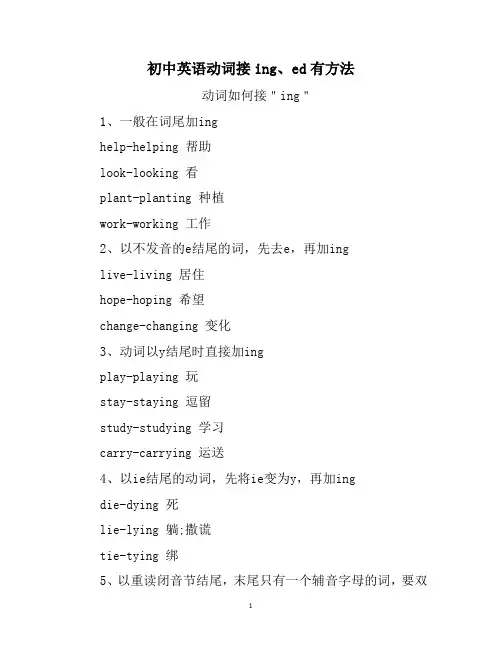
初中英语动词接ing、ed有方法动词如何接"ing"1、一般在词尾加inghelp-helping 帮助look-looking 看plant-planting 种植work-working 工作2、以不发音的e结尾的词,先去e,再加inglive-living 居住hope-hoping 希望change-changing 变化3、动词以y结尾时直接加ingplay-playing 玩stay-staying 逗留study-studying 学习carry-carrying 运送4、以ie结尾的动词,先将ie变为y,再加ingdie-dying 死lie-lying 躺;撒谎tie-tying 绑5、以重读闭音节结尾,末尾只有一个辅音字母的词,要双写这个辅音字母,然后再加ingdrop-dropping 掉落begin-beginning 开始run-running 跑prefer-preferring 更喜欢6、少数双音节动词,尽管重音不在后面,可以双写末尾的辅音字母,然后再加ingtravel-traveling (美语)旅行travel-travelling(英语)旅行动词如何接"ed"1. 一般在词尾加“-ed”help-helped-helped 帮助look-looked-looked 看plant-planted-planted 种植work-worked-worked 工作2. 以不发音e结尾的词加“-d”live-lived-lived 居住hope-hoped-hoped 希望change-changed-changed 变化3.名词以“元音字母+y”结尾时,加“-ed”;以“辅音字母+y”结尾时,变 y为i,再加“-ed”play-played-played 玩stay-stayed-stayed 逗留study-studied-studied 学习carry-carried-carried 运送4. 以重读闭音节结尾,末尾只有一个辅音字母的词,要双写这个辅音字母,然后再加ed。
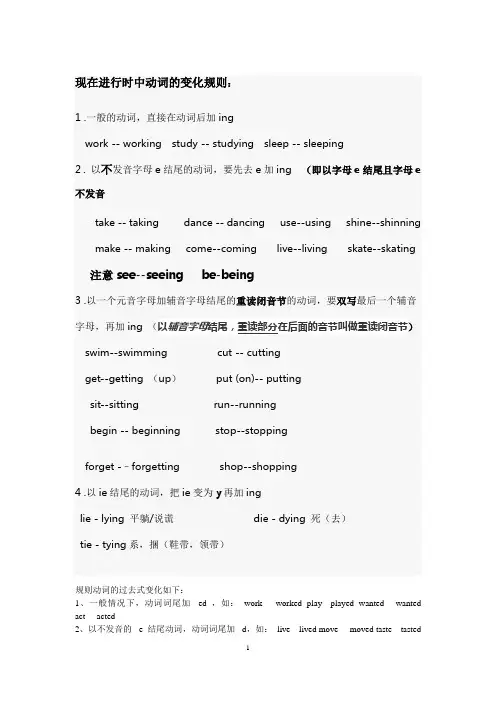
现在进行时中动词的变化规则:1 .一般的动词,直接在动词后加ingwork -- working study -- studying sleep -- sleeping2 . 以不发音字母e结尾的动词,要先去e加ing (即以字母e结尾且字母e 不发音take -- taking dance -- dancing use--using shine--shinning make -- making come--coming live--living skate--skating 注意see--seeing be-being3 .以一个元音字母加辅音字母结尾的重读闭音节的动词,要双写最后一个辅音字母,再加ing (以辅音字母结尾,重读部分在后面的音节叫做重读闭音节)swim--swimming cut -- cuttingget--getting (up)put (on)-- puttingsit--sitting run--runningbegin -- beginning stop--stoppingforget -–forgetting shop--shopping4 .以ie结尾的动词,把ie变为y再加inglie - lying 平躺/说谎die - dying 死(去)tie - tying系,捆(鞋带,领带)规则动词的过去式变化如下:1、一般情况下,动词词尾加-ed ,如:work ---worked play---played wanted----wanted act----acted2、以不发音的-e 结尾动词,动词词尾加-d,如:live---lived move----moved taste---tastedhope---hoped3、以辅音字母+ y结尾的动词,把-y变为-i 再加-ed,如:study---studied copy---copied cry---cried carry---carried4、以一个辅音字母结尾的重读闭音节动词,双写词尾辅音字母,再加-ed,如:stop ---stopped5、不规则动词的过去式变化规律性不强,须多加记忆。
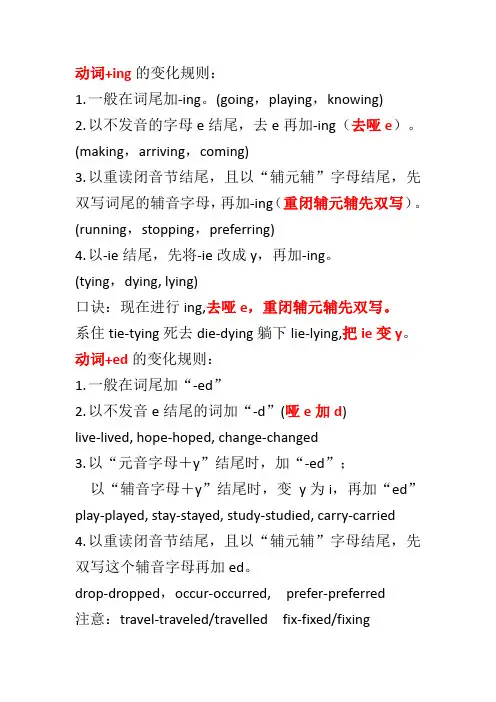
动词+ing的变化规则:
1.一般在词尾加-ing。
(going,playing,knowing)
2.以不发音的字母e结尾,去e再加-ing(去哑e)。
(making,arriving,coming)
3.以重读闭音节结尾,且以“辅元辅”字母结尾,先双写词尾的辅音字母,再加-ing(重闭辅元辅先双写)。
(running,stopping,preferring)
4.以-ie结尾,先将-ie改成y,再加-ing。
(tying,dying, lying)
口诀:现在进行ing,去哑e,重闭辅元辅先双写。
系住tie-tying死去die-dying躺下lie-lying,把ie变y。
动词+ed的变化规则:
1.一般在词尾加“-ed”
2.以不发音e结尾的词加“-d”(哑e加d)
live-lived, hope-hoped, change-changed
3.以“元音字母+y”结尾时,加“-ed”;
以“辅音字母+y”结尾时,变y为i,再加“ed”play-played, stay-stayed, study-studied, carry-carried
4.以重读闭音节结尾,且以“辅元辅”字母结尾,先双写这个辅音字母再加ed。
drop-dropped,occur-occurred, prefer-preferred
注意:travel-traveled/travelled fix-fixed/fixing。
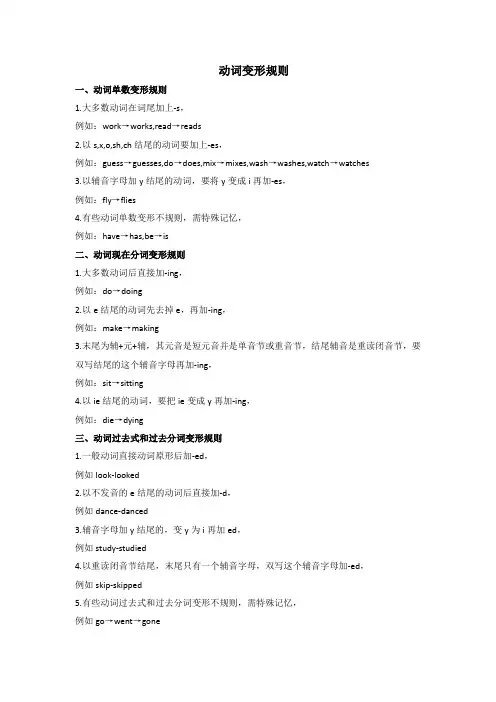
动词变形规则一、动词单数变形规则1.大多数动词在词尾加上-s,例如:work→works,read→reads2.以s,x,o,sh,ch结尾的动词要加上-es,例如:guess→guesses,do→does,mix→mixes,wash→washes,watch→watches3.以辅音字母加y结尾的动词,要将y变成i再加-es,例如:fly→flies4.有些动词单数变形不规则,需特殊记忆,例如:have→has,be→is二、动词现在分词变形规则1.大多数动词后直接加-ing,例如:do→doing2.以e结尾的动词先去掉e,再加-ing,例如:make→making3.末尾为辅+元+辅,其元音是短元音并是单音节或重音节,结尾辅音是重读闭音节,要双写结尾的这个辅音字母再加-ing,例如:sit→sitting4.以ie结尾的动词,要把ie变成y再加-ing,例如:die→dying三、动词过去式和过去分词变形规则1.一般动词直接动词原形后加-ed,例如look-looked2.以不发音的e结尾的动词后直接加-d,例如dance-danced3.辅音字母加y结尾的,变y为i再加ed,例如study-studied4.以重读闭音节结尾,末尾只有一个辅音字母,双写这个辅音字母加-ed,例如skip-skipped5.有些动词过去式和过去分词变形不规则,需特殊记忆,例如go→went→gone动词变形规则训练name___score___一、请将下列动词变成第三人称单数(15×2分=30分)work→___guess→___do→___mix→___play→___read→___wash→___watch→___fly→___have→___study→___finish→___go→___stay→___carry→___二、请将下列动词变成现在分词(15×2分=30分)climb→___eat→___write→___leave→___put→___plan→___stop→___carry→___open→___give→___take→___use→___lie→___swim→___forget→___三、请将下列动词变成过去式和过去分词(20×2分=40分)call→___→___study→___→___play→___→___fly→___→___sing→___→___plan→___→___move→___→___smile→___→___try→___→___enjoy→___→___sleep→___→___read→___→___come→___→___stop→___→___take→___→___drive→___→___begin→___→___bring→___→___find→___→___say→___→___动词变形规则一、请将下列动词变成第三人称单数work→works, guess→guesses, do→does, mix→mixes, play→plays,read→reads, wash→washes, watch→watches, fly→flies, have→has,study→studies, finish→finishes, go→goes, stay→stays, carry→carries二、请将下列动词变成现在分词climb→climbing, eat→eating, write→writing, leave→leaving, put→putting, plan→planning, stop→stopping, carry→carrying, open→opening,give→giving, take→taking, use→using, lie→lying, swim→swimming, forget→forgetting三、请将下列动词变成过去式和过去分词call→called→called, study→studied→studied, play→played→played,fly→flew→flown, sing→sang→sung, take→took→take,move→moved→moved, smile→smiled→smiled, try→tried→tried,enjoy→enjoyed→enjoyed, sleep→slept→slept, read→read→read,come→came→come, stop→stopped→stopped, plan→planned→planned, drive→drove→driven, begin→began→begun, bring→brought→brought,find→found→found, say→said→said,。
动词变单三的规则:1. 一般的动词在词尾加---s. work—works, read----reads2. 以s,x,ch,sh,及辅音字母+o结尾的单词在词尾加---es. Watch---watches,do----does.3. 以辅音字母加y结尾的动词变y为i,再加---es. fly---flies.4. 以元音字母加y结尾的动词直接在词尾加—s. play---plays5. 不规则变化。
如:have---has动词变现在分词(ing)的规则:1. 一般情况在词尾加---ing. 如:work---working.2. 以不发音字母e结尾的,去e再加—ing.如:take---taking,make---making.3. 以重读闭音节结尾且末尾只有一个辅音字母的,要双写末尾的辅音字母再加—ing.如:swim---swimming, run ---running.4. 以字母ie结尾的动词,将ie变为y再加ing。
如:die---dying.动词过去式变化规则:1.一般在动词末尾加-ed,如:pull-pulled, cook-cooked2.结尾是e加d,如:taste-tasted3.末尾只有一个元音字母和一个辅音字母的重读闭音节,应双写末尾的辅音字母,再加-ed,如:stop-stopped4.以“辅音字母+y”结尾的,变y为i,再加-ed,如:study-studiedAB型can could shall should will would may mightAAA型cost cost cost cut cut cut hit hit hit hurt hurt hurt let let letmust must must put put put set set set shut shut shut read read readAAB型beat beat beatenABA型become became become come came come run ran runABB型bring brought brought buy bought bought think thought thoughtcatch caught caught teach taught taught build built builtlend lent lent send sent sent spend spent spentdig dug dug hang hung hung feel felt feltkeep kept kept sleep slept slept sweep swept sweptleave left left smell smelt smelt spill spilt spiltlay laid laid pay paid paid say said saidsell sold sold tell told told sit sat satspit spat spat stand stood stood understand understood understoodlearn learnt learnt mean meant meant spoil spoilt spoiltshine shone shone win won won have had hadmake made madehear heard heardfind found foundhold held heldABC型begin began begundrink drank drunkring rang rungsing sang sungsink sank sunkswim swam swumblow blew blownfly flew flowngrow grew grownknow knew knownthrow threw throwndraw drew drawnshow showed shown break broke broken choose chose chosen forget forgot forgotten freeze froze frozen speak spoke spoken wake woke wokendrive drove driveneat ate eatenfall fell fallengive gave givenhide hid hiddenride rode riddenrise rose risentake took takenmistake mistook mistaken write wrote writtenam/is was beenare were beendo did donego went gonelie lay lainsee saw seenwear wore worn易错型show showed showndraw drew drawnfall fell fallenfeel felt felthold held heldhelp helped helpedthink thought thoughtthank thanked thankedtake took takentalk talked talkedget got gotforget forgot forgottenmeet met metmean meant meanthit hit hithide hid hiddenring rang rungbring brought broughteat ate eatenbeat beat beatenlie lay lainlay laid laidfind found foundfound founded foundedbuy bought boughtbring brought broughtlearn learnt learnthear heard heard5.过去式和过去分词有两种形式(以下全是ABB)burn burned burnedburnt burntlearn learned learnedlearnt learntsmell smelled smelledsmelt smeltspell spelled spelledspelt speltshine shined shinedshone shoneleap leaped leapedleapt leapt。
初中阶段需双写最后一个字母再加ing、ed总结1、以重读闭音节结尾,末尾只有一个辅音字母的动词,即一个元音加一个辅音结尾并且重读时(重读闭音节)要双写这一辅音字母,再加-ing。
例如:run-running, swim-swimming等。
(或在重读闭音节里,末尾只有一个辅音字母,辅音字母前只有一个元音字母时,要双写这个辅音字母。
辅-元-辅好像更好记)内在的道理就是:动词+ing或+ed后,必须保证主干的发音不变举例:正确: cutting分成两个音节:cut.ting,前半部分发音和动词原型cut一样. 错误: cuting分成两个音节:cu.ting,前半部分发音就变了.所以,对于重读单元音后只有一个辅音字母结尾的,必须双写这个辅音字母。
如果不双写,那么,这个辅音字母和ing或ed组成音节,前面的音节就由闭音节变成开音节了!举一反三:双写一般是为了使读音不便,但有时,双写会使读音发生变化,如write的过去分词是written,所以:write中的i是开音节,读成[ai],written中的i由于双写了t变成了闭音节,读成[i]。
关于“双写的问题”很简单地说:就是一个单词无论多长,在考虑是否“双写”时,只需要看最后3个字母即可--即如果最后3个分别是由“辅元辅”(辅音,元音,辅音)构成的话,那么这个单词就需要“双写”,如果不是,那么就不用了。
但是有一个单词是例外,就是listen这个单词,虽说结尾3个字母符合“辅元辅”规则,但是这个单词却不双写,而是listening.*重读闭音节三要素:(1). 必须是重读音节;(2). 最后只有一个辅音字母;(3).元音字母发短元音如:begin ,ap/ple a p 就是一个闭音节2、以-al,-er,-ill,-el结尾的动词,即使重音不在最后一个音节上,也要双写,再加-ing 如:travelling 等。
3、在最后一个字母不是A E I O U其中一个时,而最后一个字母的前一个字母是A E I O U(元音)其中一个时,就要双写最后一个字母,但如果而最后一个字母的前一个字母的前一个字母是元音的话就不能双写最后一个字。
英语动词中,字母双写的情况:双写加ing,双写加ed,规则:在重读闭音节里,末尾只有一个辅音字母,辅音字母前只有一个元音字母时,要双写这个辅音字母。
辅-元-辅关于“双写的问题”,很简单地说:一个单词只需要看最后3个字母是由“辅元辅”构成,那么就需要“双写”,如果不是,那么就不用了。
但是listen例外, listening. 动词加ed双写的有:stop ,drop ,fit, prefer,refer , travel , drop, con trolnod , plan, permit, regret, drop,begin --beginning cut ---- cuttingdig ---- digging get ---- gettinghit ---- hitting let ---- lettingput ---- putting run ---- runningset ---- setting shut ---- shuttingsit ---- sitting spit ---- spittingsplit ---- splitting swim ---- swimmingwin ---- winning beg—begged.sum – summed spot - spottedman – manned rub - rubbedskip-skipped shop-shopped英语中形容词和副词有三种等级:原级,比较级及最高级。
规则形容词和副词变比较级和最高级的规则如下:❖单音节词末尾加-er和-est, 如:great-greater-greatest❖单音节词如以-e结尾,只加-r和-st, 如:brave-braver-bravest ❖闭单节单音节词如末尾只有一个辅音字母,须先双写这个辅音字母,再加-er和-est,如:big-bigger-biggest❖少数以-er, -ow, -ble结尾的双单节词,末尾加-er和-est,如:clever-cleverer-cleverest; narrow-narrower-narrowest;❖以-y结尾的词,如-y前是辅单字母,则变y为i,再加-er 和-est, 如:happy-happier-happiest.❖其他双音节和多音节词皆在前面加单词more和most。
动词-ing形式的构成一、在一般情况下,在动词原形后直接加词尾–ing。
eg. go – going; do – doing; ask – asking; read --- reading特别要注意:这和第三人称一般现在时的词尾变化不同,动词词尾如为“辅音字母+ y”时不变,在其后直接加–ing。
eg. study – studying; carry – carrying; fly – flying; worry – worrying;二、在以不发音的e 结尾的动词后,去掉e,再加- ing。
eg. come – coming live – living dance – dancing make – making三、在闭音节的单音节动词后、以重读闭音节结尾的多音节动词,而末尾只有一个辅音字母时,将这个辅音字母双写(x除外),然后再加–ing.。
sit – sitting; run – running; begin – beginning; forget – forgetting四、在少数几个以–ie 结尾的动词后:须将–ie 变作y,再加- ing。
eg. die – dying; tie – tying lie – lying一、一般情况下,动词词尾加-ed 。
如:work ---worked play---played wanted----wanted act----acted二、以不发音的-e 结尾动词,动词词尾加–d。
如:live---lived move----moved taste---tasted hope---hoped三、以辅音字母+ y结尾的动词,把-y变为-i 再加-ed。
如:study---studied copy---copied cry---cried carry---carried四、以一个辅音字母结尾的重读闭音节动词,双写词尾辅音字母,再加-ed,如:stop ---stopped mop----mopped equip---equipped prefer---preferred五、不规则动词的过去式变化规律性不强,须多加记忆。
动词过去式变化规则及其读音规则规则动词的过去式变化如下:1、一般情况下,动词词尾加-ed ,如:work ---worked play---play ed wanted----wanted act----acted2、以不发音的-e 结尾动词,动词词尾加-d,如:liv e---liv ed mov e----mov ed taste---tasted hope---hoped3、以辅音字母+ y结尾的动词,把-y变为-i 再加-ed,如:study---studied copy---copied cry---cried carry---carried4、以一个辅音字母结尾的重读闭音节动词,双写词尾辅音字母,再加-ed,如:stop ---stopped5、不规则动词的过去式变化规律性不强,须多加记忆。
go – went make – made get – got buy - bought come - came f ly-flew不规则动词的过去式的构成1.把动词原形中的i改为a,变成过去式。
如:begin—began,drink—drank,giv e—gav e,ring—rang,sing—sang,sit—sat,swim—swam 2.把重读开音节中的i改为o,变成过去式。
如:driv e—drov e,ride—rode,write—wrote3.改动词原形中的aw /ow为ew,变成过去式。
如:draw—drew,grow—grew,know—knew,throw—threw(动词show除外,show—showed)4.动词原形中的e改为o,变成过去式。
如:get—got,f orget—f orgot5.动词原形中的ee改为e,变成过去式。
如:f eed—f ed,meet—met6.动词原形中的eep改为ept,变成过去式。
如:keep—kept,sleep—slept,s weep—swept7.动词原形中的eak改为oke,变成过去式。
如:break—broke,speak—spoke8.动词原形中的ell改为old,变成过去式。
如:sell—sold,tell—told9.动词原形中的an改为oo,变成过去式。
如:stand—stood,understand—understood10.以ought和aught结尾,且读音是〔:t〕的过去式。
如:bring—brought,buy— bought,think—thought,catch—caught,teach—taught11.以ould结尾且读音为〔ud〕的情态动词过去式。
如:can—could,shall—should,will—would12.把动词原形中的o改为a,变成过去式。
如:come—came,become—became13.在动词原形后加d或t变成过去式,并且发生音变。
如:hear〔hi 〕—heard〔h :d〕,say〔sei〕—said〔sed〕,mean〔mi:n〕—meant〔ment〕14.动词的过去式与动词原形一样。
如:let—let,must—must,put—put,read—read〔red〕15.不符合上述规律的动词过去式。
如:am,is—was,are—were,build—built,do—did,eat—ate,f all—f ell,f eel—f elt,f ind—f ound,f ly—f lew,go—went,hav e /has—had,hold—held,leav e—lef t,make—made,may—might,run—ran,see—saw,take—took过去式―-ed‖的发音规则(1)动词词尾为―t,d‖时,发/ id /音,want →wanted (要)need →needed (需要)(2)动词词尾为清辅音时,发/ t / 音。
help →helped (帮助)laugh →laughed (笑)look →looked (看)k iss →kissed (吻)wash →washed (洗)watch →watched (注视)(3)动词词尾为t,d以外之浊辅音或元音时,发/ d /音。
call →called (叫)stay→stay ed (停留)cry→cried (哭)过去式是英语语法的一种,表示过去某个时间里发生的动作或状态。
一般过去式的动词通常用动词的过去式形式来表示,而动词的过去式是在动词原形的基础上变化的。
动词的过去式可分为规则动词和不规则动词。
目录过去式,过去时态【过去式】1、过去发生的而现在已经结束的动作要用一般过去式来表示。
2、表示过去某个时间里发生的动作或状态。
3、过去习惯性、经常性的动作、行为;过去主语所具备的能力和性格。
【过去时态】表示行为、动作和状态在各种时间条件下的动词形式。
【过去时态结构】指的是过去时态下的动词形式的语法构成。
过去式就是动词的变化,表示过去发生的事。
一般看到ago,before, in 几几年,就是过去式。
work-workedlisten-listened 一般的就是直接加ed,特殊的就有一些变化。
结构【过去时态结构基本形式】1、主语+动词过去式+其他;2、否定形式①wasn't/weren't②在行为动词前加didn't,同时还原行为动词;一般疑问句Did+主语+do+其他。
概念:表示过去的发生动作或过去存在的某种状态例句:A:What did you do last weekend?B:I played football.A:Did you read books?B:Yes,I did.构成表示一般过去式的动词通常用动词的过去式形式来表示,而动词的过去式是在动词原形的基础上变化的。
动词的过去式可分为规则动词和不规则动词。
规则动词的过去式变化如下:(1)一般情况下,动词词尾加 ed ,如:work—worked; play—played;want— wanted; act—acted(2)以不发音的 e 结尾动词,动词词尾加 d,如:live—lived; move—moved; decide—decided; decline—declined;hope—hoped;(3)以辅音字母 + y结尾的动词,把y变为i 再加ed,如:studied tried copied justified cried carried embodied emptied(4)以一个辅音字母结尾的重读闭音节动词,双写词尾辅音字母,再加 ed,如:stopped begged fretted dragged dropped planned dotted dripped (5)注:不规则动词的过去式变化规律性不强,须多加记忆。
go - went,make - made,get - got ,buy - bought ,come - came ,fly-flew ,is/am-was,are-were ,see-saw,bring-brought,do-did,teach-taught, think-thought, say-said,sit-sat. read-read,spend-spent,eat-ate,give-gave,sit-sat,tell-told,write-wrote,feel-felt,find-fo und,hear-heard,know-knew,put-put,grow-grew,take-took,catch-caught,come-came,become-became, swim-swam,sweep—swept,sing—sang,draw—drew,以上的(1)至(4)条中的发音均有改变,具体分别有/d/ /t/ /id/。
而不规则动词的过去式的发音则略有不同,但是有些还是按照一定规律变化的。
如以上的:make - made,get - got ,buy - bought ,come - came ,fly-flew ,bring-brought,teach-taught, think-thought,say-said,sit-sat. read-read,spend-spent,give-gave,tell-told,write-wrote,feel-felt,find-found, hear-heard,know-knew,put-put,grow-grew,take-took,catch-caught,come-came,become-became,swim-swam,sweep—swept,sing—sang,draw—drew。
仔细看一看,能发现它们的一些变化规律,也就是说不需要死记硬背这些过去式,知道了原型和变化规律,就可以写出来了。
有的变化部分读音也是有规律的。
分类记忆是对学习过去式很有帮助的!用法:(1)表示过去某一时刻或某一段时间内所发生的动作或情况,通常一般过去式带有表示动作时间状语的词,词组或从句,如 yesterday, the day before last, last week, two days ago 等,上下文清楚时可以不带时间状语。
I worked in that factory last year. 去年我在那一家工厂工作。
I went to the Tian Long Mountain yesterday. 昨天我们去了天龙山。
一般过去时的用法一.概念:一般过去时是表示在过去的时间里发生的动作或状态,通常与表示过去的时间状语连用。
二.时间状语:yesterday, the day before yesterday, two days ago, long long ago,a minute ago,last year(week, month), just now, at that time, in those days.三.过去时的用法:1.有确定的过去时间状语时要用过去式。
例:We had a good time last week.2.表示过去连续发生的动作时,要用过去式。
例:The boy closed the door, turned off the window, and then went to bed.3. 表示过去一段时间内经常或反复的动作,要用过去式。
例:She often came to help me at that time.四.一般过去式的构成形式:☆Be动词的过去式: (1)肯定句:主语+ be动词的过去式(was, were)例:He was ill yesterday. She was nine two years ago.They were my students long long ago.(2)否定句:主语+ be动词的过去式(was, were)+ not例:He was not ill yesterday.She was not nine two years ago.They were not my students long long ago.(3)一般疑问句:直接把be动词提到句首。